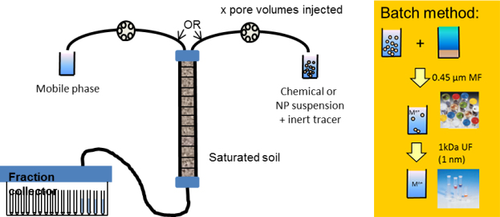WP7
ENM fate and transport in terrestrial systems
Lead: Geert Cornelis, Swedish Agricultural University (Uppsala)
This work package develops a modelling framework for engineered nanomaterials in soils. Nanomaterials could reach soils mainly after the deposition of wastewater treatment sludge. This sludge contains much valuable organic carbon and nutrients for agricultural soils. Soils therefore are a sink for nanomaterials, where concentrations develop over time.

Much of the model development for soils revolves around developing so called fate descriptors, i.e. the physical parameters required for a model to calculate, as well as the methods of how to determine them. The most important fate descriptor for soils is the partitioning coefficient in the case of conventional chemicals. However, such a coefficient assumes some sort of equilibrium develops where the chemical’s concentration reaches a steady state both in the liquid part of the soil, the soil pore water, and the solid part of the soil. Such an equilibrium does not develop for nanomaterials and the transport of nanomaterials has to be looked at with different eyes and from a kinetic perspective.
A major task of WP 7 is therefore the quest for such a descriptor and the method to determine it. Column tests are possibly a suitable alternative, but these are lengthy and expensive tests that are thus not fit to provide the large amount of data we need. We wish to shed light on how different nanomaterials with different properties behave in different soil types. This requires a faster method to provide a lot of data.

We also seek to model how the speciation of nanomaterials changes in soil as a function of time. Many nanomaterials are highly reactive and change to less reactive counterparts. If such is the case for many different nanomaterials so that they all evolve to the same form, risk assessment becomes less complex to describe, because the original diversity of nanomaterials matters much less in that case.
The model itself then combines both speciation and fate descriptors to predict the fate of a wide range of nanomaterials in different soils. This allows us to predict and classify the soil types that are most vulnerable should they be exposed to nanomaterials. At the same time, it also provides us with invaluable knowledge for those cases where nanomaterials are intentionally added to soils. Two cases are studied: zerovalent iron and pesticides. Zerovalent iron is being developed to remediate certain organic and inorganic contaminants such as halogens, chromium and arsenic in soils. Nanopesticides are developed as a more efficient and safe alternative to conventional pesticides. The efficient and safe application of both these nanomaterials requires knowledge of how they are transported in different soils, thus extending the impact of NanoFASE to both current nanomaterials and future applications.
